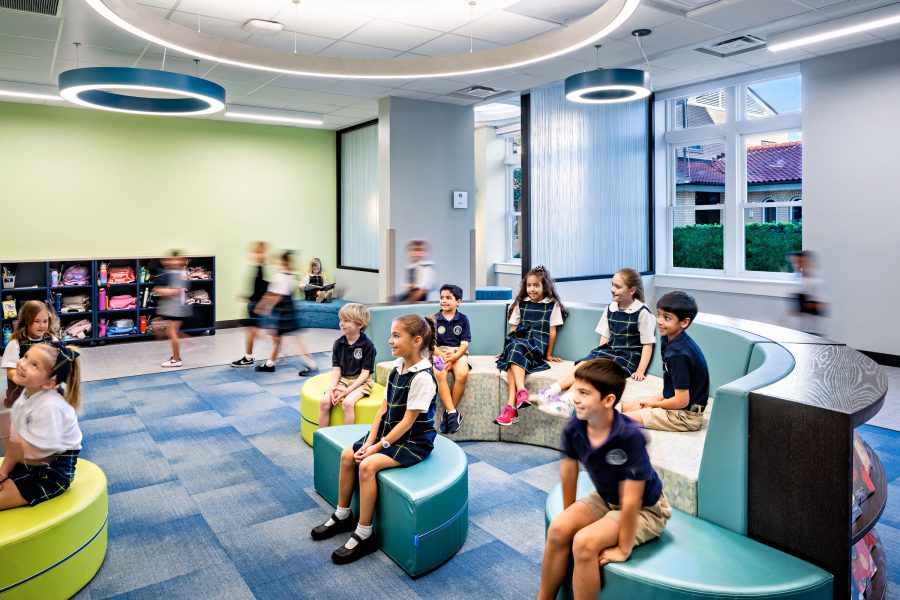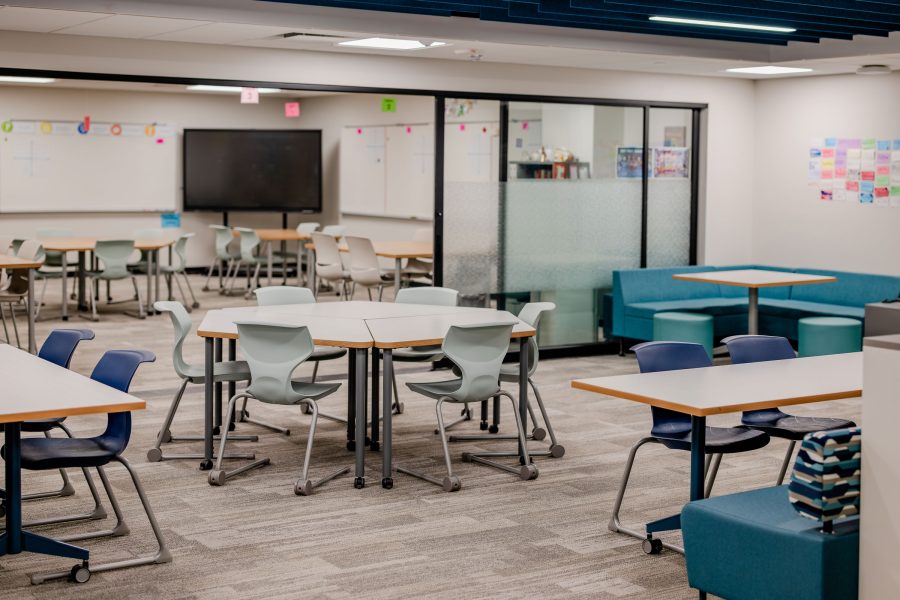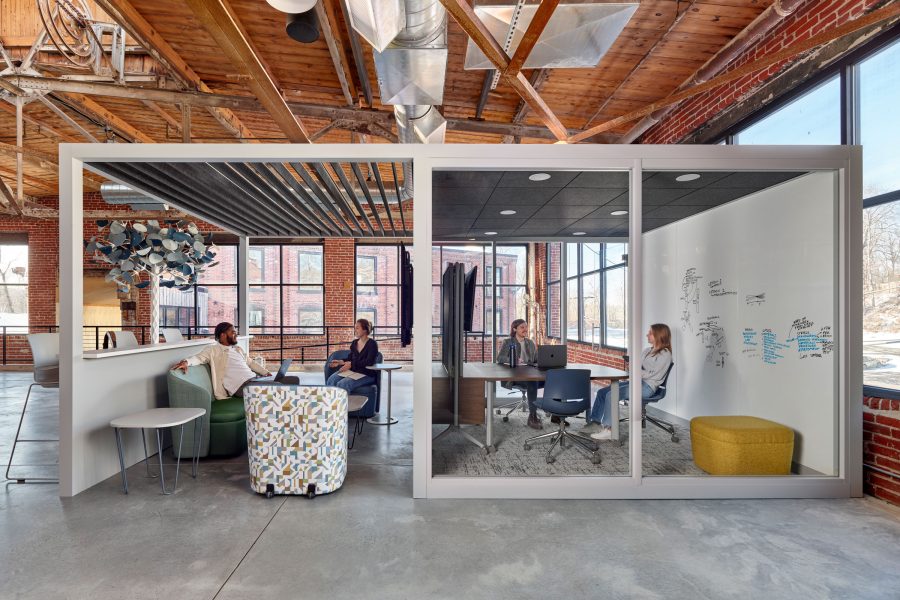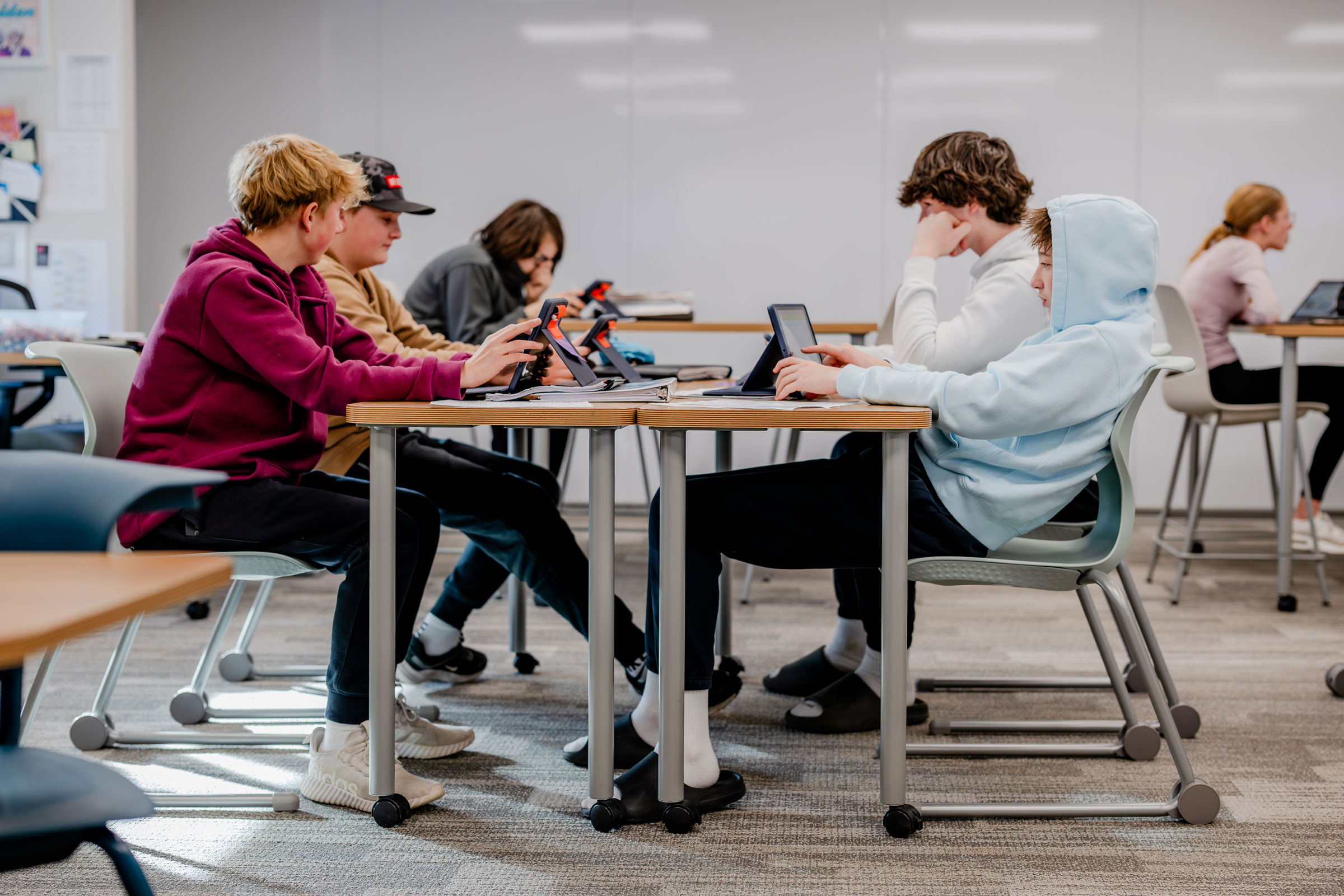Story at a glance:
- Thoughtful furniture significantly impacts students’ posture, sensory experiences, and engagement.
- Flexibility in educational furnishings supports diverse learning styles and evolving teaching methods.
- Industry leaders advocate a holistic approach, aligning architecture and furniture for student well-being.
Step into any K12 classroom today, and you’ll notice something vastly different from the rigid desks and cold chairs of decades past. You’ll find dynamic, customizable spaces where furniture complements new teaching styles, curricula, and diverse, digital-native learners.
“Now even kids carry around a source of information … at their fingertips,” says Brett Sumrow, principal and education sector leader at Corgan, an architecture and design firm that has pushed educational design forward for more than 80 years. Sumrow himself has spent 25 years championing progressive concepts—like collaborative spaces and outdoor education—that reshape how learning occurs.
“As a result the role of the teacher has really changed to be more of a facilitator,” he says. “It’s about getting away from teacher-centered to student-centered education. Different students learn at different rates because they have access to information. The teacher becomes more of a guide through that process.”
These changes aren’t just aesthetic—they’re intentional and personal. Educators, architects, and furniture designers increasingly recognize the built environment’s profound impact on how students learn and grow. Designing for young learners is now a specialized pursuit, blending architecture and furnishings to meet developmental needs and a changing technological landscape. And schools are now working directly with architects and designers to bring these forward-thinking dreams to life.
How Learning is Changing

MyPlace curved shelving is a unique solution for compact storage and dynamic division of space. Photo by Randy Van Duinen, courtesy of KI
Sumrow says good design supports diverse learners by allowing physical movement, providing comfortable sensory experiences, and enhancing concentration—all directly tied to academic performance and student well-being. He points to research showing that if you listen to someone lecturing, you retain less information. He says the upper levels of learning involve experiential learning that is hands-on.
“Moving around or interacting with one another. Now we want spaces where three kids can really focus on a conversation, or a class of 20 or 25 can report out. Sometimes multiple classes come together, so you need spaces where they fit comfortably. Learning spaces spill beyond the walls of a classroom. Classrooms used to be the basic component; now we’re looking at the entire campus as educational space.”
This understanding shapes both architecture and furniture manufacturing. KI, a pioneer in purposeful furniture design, actively engages in this shift. Recognizing the critical link between furniture and students’ development, KI pushes innovative, holistic solutions into classrooms nationwide.
“It all starts with a mission,” says Jason Lazarz, KI’s A&D market leader. “How do we support and elevate student engagement? For KI that’s looking at the whole environment. How are students learning at each age? What are they learning at each age? What are the teacher’s needs? What are the storage needs? What role is technology playing? From there we look at furniture pieces in more specific terms like function, scale, and ergonomics, but it all starts with that bigger picture.”
Furniture for Flexible Learning

Ruckus innovative seating promotes student movement and lets users choose how they relate to their learning spaces. Photo courtesy of KI
Among KI’s notable innovations is the Cogni chair, designed to integrate gentle movement. Young learners often struggle to remain still; Cogni subtly supports their natural inclination toward motion, enhancing attentiveness without disruption. Featuring patented heel-wheel technology for controlled mobility, tactile sensory surfaces, and adaptive seating, Cogni keeps students grounded and engaged.
“Cogni is important because it solves several classroom problems,” Lazarz says. “First, it’s comfortable. The frame provides a bit of flex, so it doesn’t feel rigid under the body. There’s a sensory feature underneath the seat that adds a tactile, self-soothing element. And our patented heel-wheel feature makes the chair impossible to tip, which is a real concern in classrooms.”
Similarly, the WiggleRoom Super Structure addresses sensory needs for students who find traditional seating restrictive. A flexible, freestanding system from KI Wall, WiggleRoom structures allow educators to create distinct spaces for students to concentrate, collaborate, or unwind. It has customizable glass or solid walls, integrated lighting, ventilation, and power, and can fit into any classroom seamlessly to make for an even more inclusive environment. It’s even a Certified Autism Resource.
Research increasingly validates furniture choices that allow students to move while learning. Adjustable sit-to-stand desks improve students’ posture, reduce restlessness, and enhance focus. When students can shift positions during the day, studies show reduced fatigue and fewer behavioral disruptions. Soft seating solutions further encourage comfort, collaboration, and inviting atmospheres students find engaging.
Holistic Design

The Cogni Task Chair offers an elevated aesthetic that comfortably adapts to user movements. Photo by Graham Images, courtesy of KI
But furniture alone does not define successful education design. Integrating the physical layout of schools and furnishings plays a crucial role. Corgan advocates designing schools holistically, integrating furniture choices from the start for cohesive, effective spaces. Aligning furniture and architecture creates environments that inspire learning and emotional safety rather than stagnate or contain it.
Modern furniture designs also address crucial health concerns historically overlooked. Poorly designed seating contributes to posture-related issues, from back pain to difficulty concentrating. New furniture actively supports healthy posture, comfort, and physical well-being from a young age—an investment that pays off long after academic achievement.
“Furniture manufacturers have really picked up on the need for flexibility and movement,” Sumrow says. “They’ve gotten very creative, providing nesting tables—which allow individual or group setups—and chairs that function as stools, standard chairs, or kneeling supports, all designed to improve posture and physical comfort.”
Forward-thinking educational spaces embrace agile, student-focused philosophies. Beyond immediate benefits, designing with furniture in mind anticipates future shifts in teaching methodologies. Today’s classrooms must adapt to collaborative group work, quiet reflection, hands-on projects, and technology-enhanced learning—all requiring thoughtfully designed spaces.
Furniture manufacturers have really picked up on the need for flexibility and movement.
“Flexibility is big,” Sumrow says. “Research shows that if students have some say in their environment, they’re more engaged and perform better. It can be as simple as letting a kid choose their seat. Sometimes we select furniture with multiple options—counter-height tables, standard tables, or soft seating—empowering students and supporting comfort.”
Manufacturers like KI continually respond to educators’ evolving needs, providing a crucial link between educational theory and practical application. Equally critical is KI’s dedication to sustainability. The company emphasizes product life cycle, designing furniture that can be easily adapted or repaired by the end user, allowing for decades of use. This significantly extends product longevity and reduces waste, aligning environmental responsibility with practical solutions for schools.
“For many new products we’re moving to a lifetime warranty,” Lazarz says. “We design furniture to be repairable by component, so if something breaks it can be replaced without discarding the entire piece. We also provide instructions for disassembly when it reaches the end of its life, clearly identifying recyclable components. It’s crucial for us to divert whatever we can from landfills.”
Ultimately the future of educational design hinges on collaboration between architects, educators, and manufacturers. Each perspective contributes to environments nurturing the whole student. Leaders at Corgan and KI demonstrate how intentional, informed design can build spaces that fundamentally support students’ physical health, emotional well-being, and academic success.
“Classrooms are becoming more inspired and inviting,” Lazarz says. “Spaces look less ‘institutional,’ and that creates more supportive atmospheres for learning. Furniture, especially when it comes to inclusion, is just scratching the surface of what’s possible, and we want to push those boundaries even further.”

WiggleRoom is a flexible, freestanding system from KI Wall that allows educators to create distinct spaces for students. Photo by Jeffrey Totaro Photography, courtesy of KI

Ruckus innovative seating promotes student movement and lets users choose how they relate to their learning spaces. Photo courtesy of KI

